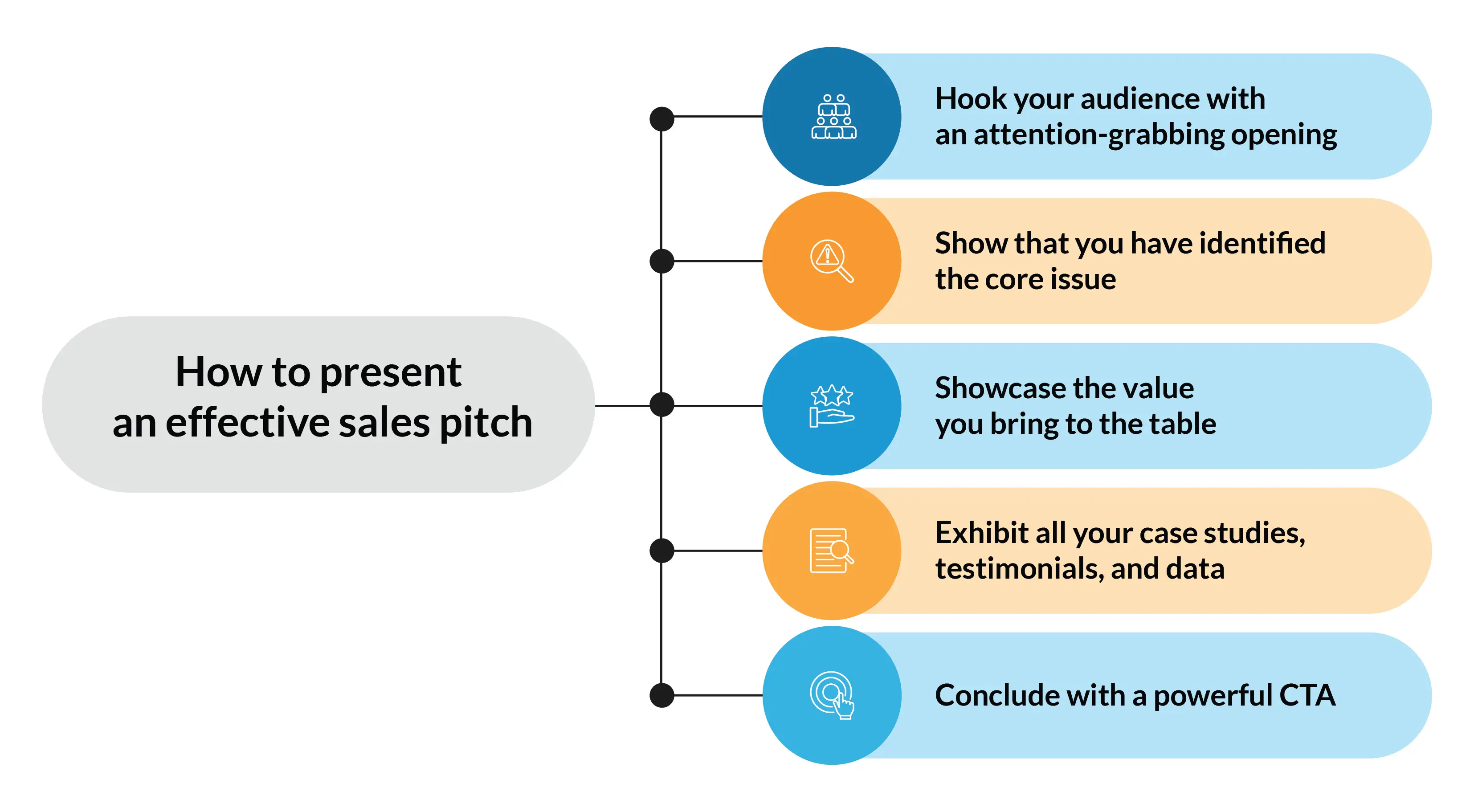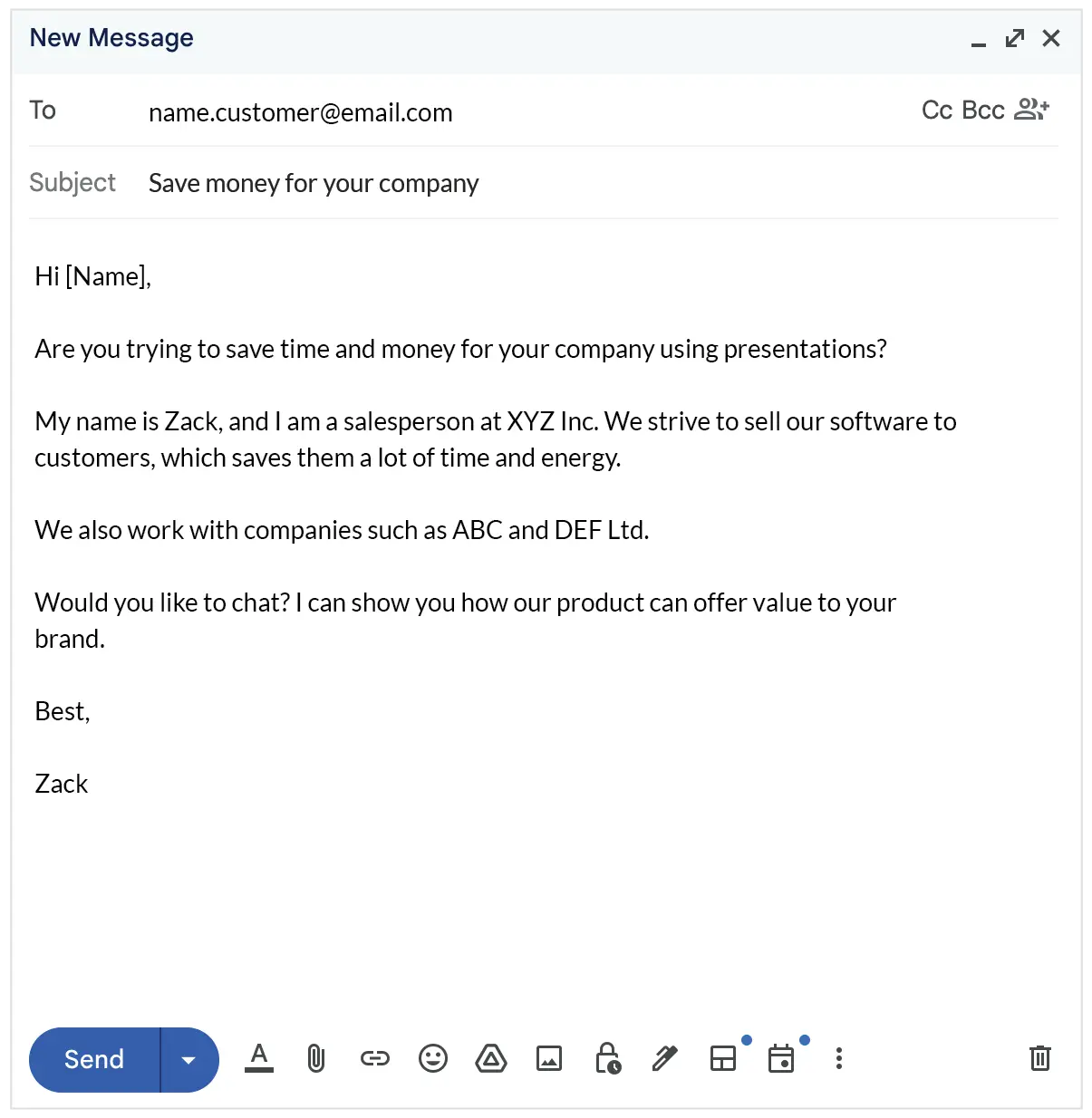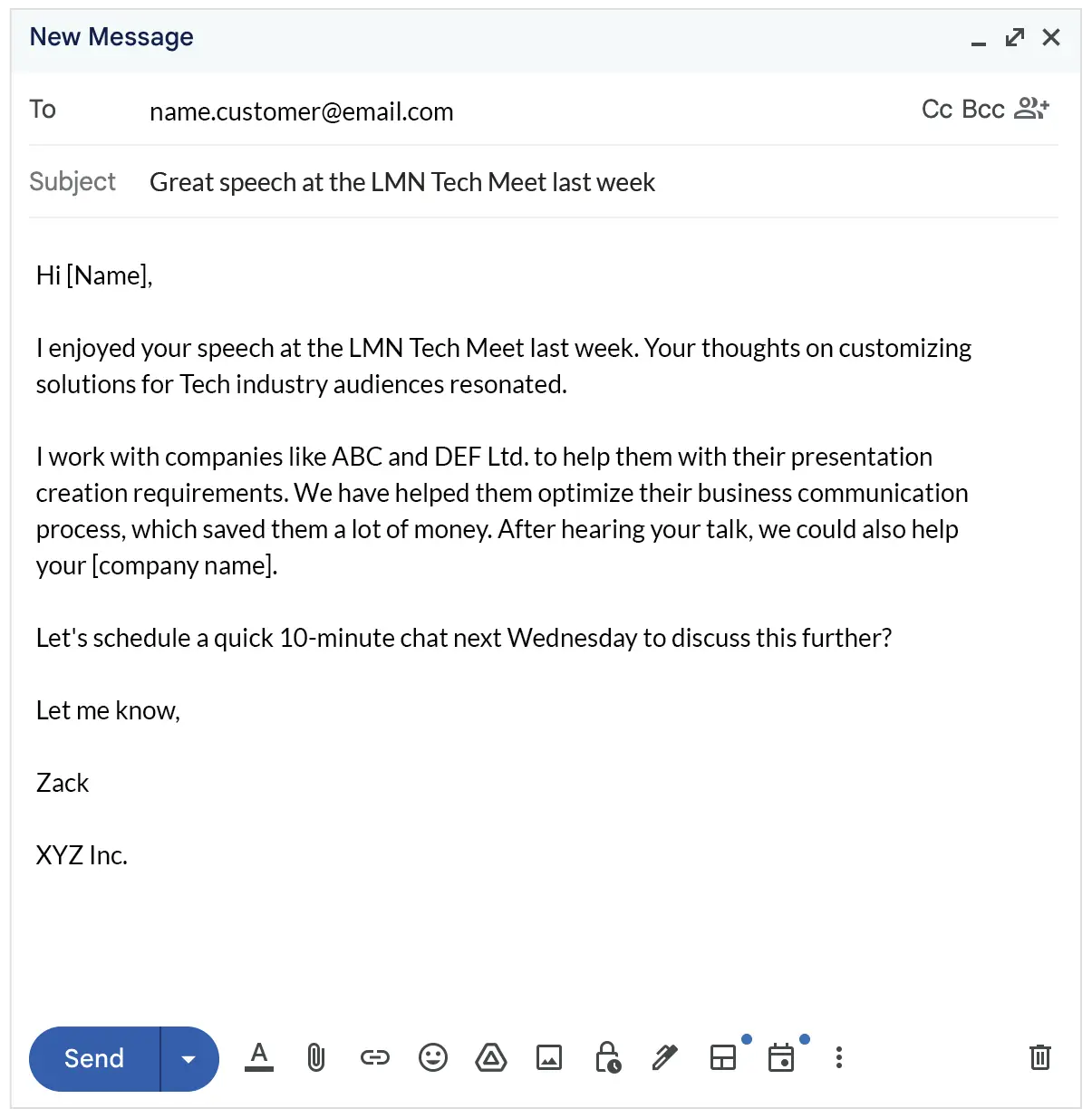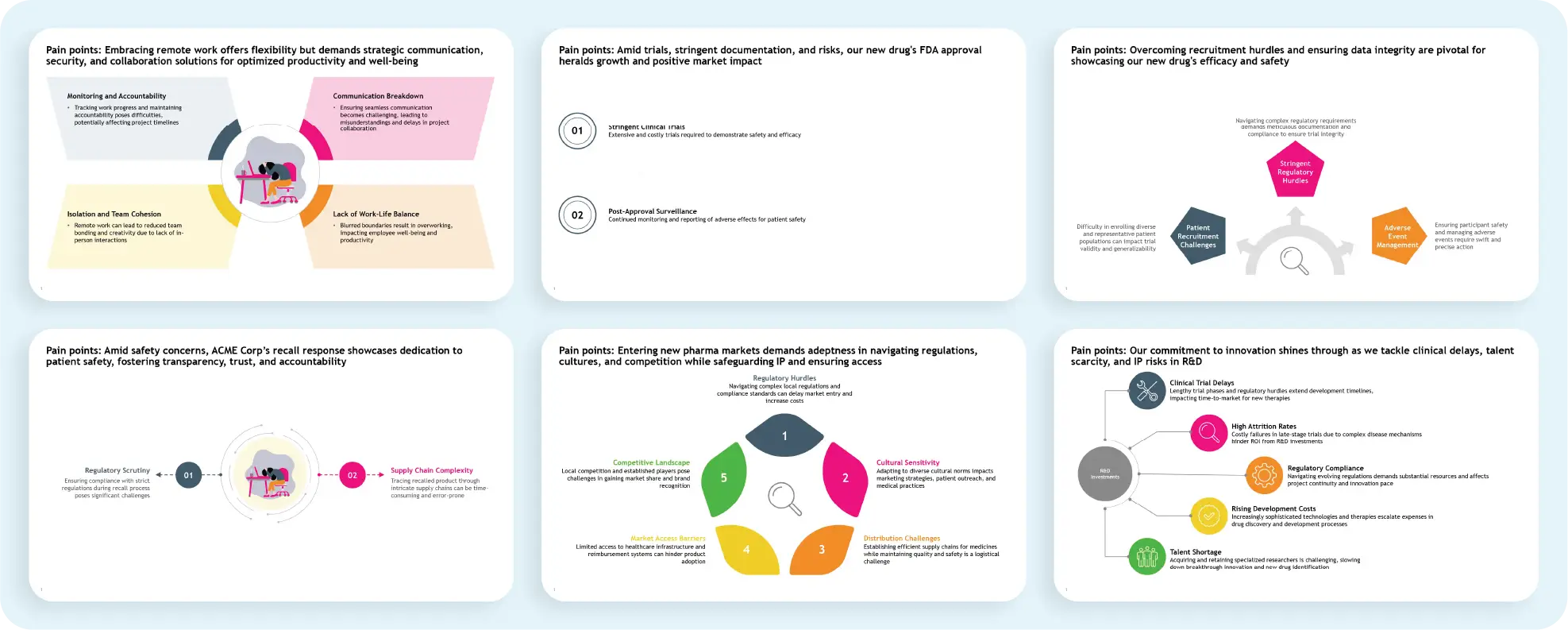7 sales pitch examples & tips to create a winning sales pitch

Crafting a great sales pitch can change the game for your business. Whether sealing the deal, launching a new product, or just trying to engage a potential customer, a well-crafted sales pitch can make all the difference!
This blog will explore the essential elements needed in sales pitches and highlight some of the best sales pitches in the business world.
What is a sales pitch?
A sales pitch is a quick and convincing message a sales rep gives to persuade a potential customer to buy a product or service. It's not just about parading your product features; it's about addressing the customer's needs, solving their problems, and showing the value your offering provides.
A good sales pitch can pique a person's interest in less than 30 seconds, which is why they are sometimes referred to as elevator pitches! It's crucial to be efficient in today's super-fast-changing business world. People's attention spans are short, so you only have a small window to make an impression. That's why it's crucial to master the sales pitch and its key components, like brevity and persuasiveness.
What are the elements of a successful sales pitch?

Understanding the essential components of a sales pitch helps the sales team communicate better, connect more deeply with potential customers, and make it more likely to turn leads into actual sales. This skill is valuable for salespeople and anyone who wants to convince or influence others. Here are elements of an effective sales pitch:
- Start with an attention-grabbing opening: Start your pitch with a hook that grabs attention—this could be a bold statement, an intriguing question, or a surprising fact. It could also include some of the following:
- Ask a provocative question: "Have you ever wondered why x happens?"
- State a surprising fact: "Did you know that 60% of businesses struggle with y?"
- Highlight a pain point: "Are you tired of dealing with z daily?"
- Highlight a pain point: "Are you tired of dealing with z daily?"
- Tell a relatable story: Start with a brief anecdote that resonates with your audience.
- Identify the core issue: Ensure you understand the problem your potential customer is dealing with. This will demonstrate that you know where they're coming from.
- Demonstrate the value proposition: Tell people how your product or service fixes the problem. Show off the benefits and what makes it unique.
- Showcase your data: Remember to showcase your work with testimonials, case studies, or data to support your claims and provide evidence and social proof.
- End with an effective call-to-action (CTA): The end of your sales pitch should have a strong, persuasive call to action to guide the potential customer to the next steps.
How do you create a perfect sales pitch?
One must understand some basic details to create a compelling sales pitch. These ensure your pitch is engaging and structured to resonate with your audience's needs and desires. Let’s take the example of Apple Inc.’s pitch to their customers to break down the best practices one should follow to create a compelling sales pitch:
Know your audience:
- Apple's pitch focuses on the new iPhone's comprehensive changes, showing a significant leap in technology and user experience. This captures the audience's attention by promising substantial value and improvements in their daily lives.
Focus on benefits, not features:
- Apple's pitch for the iPhone 6 highlighted the benefits rather than the product features or technical specifications. It implies that every aspect of the phone has been enhanced, promising a better overall experience without overwhelming the customer with details.
Be concise and straightforward:
- Despite the complexity of its technology, Apple communicates its offering in the simplest terms possible. This simplicity makes the message accessible to a broader audience, ensuring potential customers immediately grasp the value proposition.
Be authentic:
- Behind this simple message was a genuine confidence in their product's ability to change the game. Apple's presentations, famously delivered with great enthusiasm and passion, make this belief palpable, enhancing the persuasive power of their pitch.
End with a clear CTA:
- Even though it's not explicitly stated in its slogan, Apple's pitch is always followed by a clear call to action, guiding consumers to purchase or learn more about the iPhone. This is important because it helps turn people's initial interest and excitement into a clear next step.
7 sales pitch examples and pitch templates
At a time when people's attention spans are shorter than ever, a great sales pitch is significant for brands to connect with their audience. Using creativity, emotional appeal, and clear communication, some companies have nailed the art of sales, turning it into something unique.
Check out how top industry brands have crafted their messages to sell products, inspire, engage, and deeply connect with customers. These taglines and different sales pitches are more than just ads; they capture the heart and soul of the brand, making them truly unforgettable.
1. Sales pitch example 1: The phone pitch
Making cold calls or phone pitches remains the most popular and effective sales channel for a good reason: it is quick, easy, occurs in real-time, and is difficult for prospects to ignore. When crafting a phone pitch, it is crucial to incorporate the specific benefits the user will experience from your product or service.
An effective phone sales pitch was made by Mark Cuban when he bought the Dallas Mavericks in the early 2000s.
The problem:
- The team was considered the worst professional sports franchise of the '90s, resulting in low ticket sales.
The solution:
- Mark Cuban personally called past season ticket holders. In the face of objections and rejections, he reminded former ticket holders of their experiences attending games as children—when the team's performance didn't matter.
- He emphasized that the atmosphere, camaraderie, and time spent with family and friends are what mattered. It was a unique experience that provided more value than going to the movies or McDonald's (cost of ticket to the game: $8 a ticket)
The result:
- His approach proved effective, and ticket sales began to climb. Mark Cuban bought the Mavericks for $280 million; the team is now valued at $2.7 billion.
Why was the sales pitch effective?
- He was personable and established a connection with his prospects.
- He conveyed value and recognized that he wasn't selling a basketball team—he was selling a memorable experience.
Cuban could have promoted better seats, talented team players, or tasty popcorn. Instead, he highlighted a unique family experience—something he and his team knew former season ticket holders appreciated.
The important lesson: When making a phone pitch, focus on leveraging the benefits, not the features. Keep the phone sales pitch brief to any customer brief and tailor your pitch based on the listener’s feedback.
2. Sales pitch example 2: The email pitch
Emails are a great way to introduce yourself and your company while demonstrating the value of what you're selling. Effective writing is essential to keep your email outreach concise and get straight to the point.
A sales pitch via email is probably a salesperson’s best tactic. C-level executives are more likely to answer cold B2B emails than employees outside the C-suite.
Yet, to succeed at email pitches, your sales email subject lines must be click-worthy, but it's also easy to do poorly.
For example, here is a not-so-great way to pitch through email:

Why doesn't this type of pitch work?
- The email begins with an open-ended question not specific to the receiver/user.
- The benefits of the product or service need to be more clearly written.
- The mention of other customers seems more like trying to impress than showcasing the product benefits.
- It could be more apparent to the customer why this would be valuable, so they might not be willing to respond.
Here's a great example from the same person at the same made-up company:

Why does this email work better?
- It starts with something familiar, like attending a tech meet or any other shared experience.
- It makes a straightforward offering of products/offerings and shows how it can help.
- It uses personalization techniques, such as the event's name and company name. It also shows social proof and backs up the benefits with evidence.
- The salesperson isn't too pushy.
To create a cold email and communicate with the executive leadership, you can use the simple framework below:
- The opener: Personalize your opener and connect the reason for reaching out to something relevant to the user.
- The pitch: Summarize all the points into a single paragraph, using no more than 1-3 sentences.
- Call-to-action: Understand whether they would like to learn more and propose a brief call as the next step.
3. Sales pitch example 3: The fundraising pitch
A fundraising proposal or pitch is all about explaining why your project is important, asking for money, and laying out the problem, goals, plans, and how the funds will be used. It's also crucial to show that the project can be sustained long-term and that it's well-managed to build strong relationships with investors. Many organizations use this kind of pitch, but start-ups looking for financial support in their nascent stage often use the fundraising pitch.
Airbnb's presentation to potential investors was impressive for a few reasons:
- Instead of getting caught up in fancy design, they focused on delivering a clear and straightforward message.
- They effectively highlighted the problem travelers face with expensive hotel prices and then used data to show their market potential.
- They kept their presentation straightforward by focusing on their business strategy and the value they offer.
- The creators summarized the solution in just seven words - "Find listings by city, read reviews, and book your stay!"
Interestingly, Airbnb's founders, Brian Chesky and Joe Gebbia, had no previous experience with fundraising. Despite this, they secured a significant $600,000 investment from Sequoia Capital at the beginning and raised a total of $4.4 billion through various funding rounds.
4. Sales pitch example 4: The questions sales pitch
This type of sales pitch is great when you know the person you're talking to understands the value of your offering. Instead of just telling them about the benefits of your product or service, ask them a question about it.
For example, instead of saying, "Our service will save you money," ask, "Would our service help you save money?"
Why does this pitch work? This works because when people come up with their reasons for agreeing with something, they're more likely to believe it and take action.
Yet if the person you're talking to isn't sure about the value of your offering, asking a question might make them think about it even more and question whether they need it. Consider whether the person you're talking to understands and sees the value before you make your pitch.
Prezent's question slide template makes it easy for people to join in and share their thoughts on different topics. It helps get people involved and interact during sales presentations or meetings. It gives you a way to ask questions in a clear and organized manner.

5. Sales pitch example 5: The pain point pitch
A pain points sales pitch tackles the specific challenges or "pain points" that potential customers face. By focusing on these pain points, the pitch aims to show empathy and a deep understanding of the audience's issues while presenting a personalized solution.
This approach turns the conversation into a relevant and personalized discussion, making it more likely for the audience to see the value in the offering and consider it a necessary investment.
Brightwheel founder and CEO Dave Vasen did his research before his pitch at Shark Tank. He pointed out that all the Shark investors were parents, which was a pretty smart move.
The problem:
- Parents in the U.S. needed to learn what their kids were doing or up to at preschool or daycare. With 1.62 million preschoolers in the U.S., that's a lot of cluelessness.
He connected with his audience by sharing a personal experience that hit home.
The solution:
- He talked about something all parents of toddlers and pre-K kids can relate to. He used his experience with his daughter to show that his solution works.
- This tugged at the investors' heartstrings and proved that Vasen has complete confidence in his product.
The result:
- Brightwheel secured $600,000 from Mark Cuban and Chris Sacca. The company then went through several funding rounds and is now valued at $600 million.
Key takeaway: To hit the jackpot, find people's problems and devise a solution. When you give a product pitch, focus on its real-life, emotional benefits instead of drowning everyone in tech details.
You could also use a pain points slide template to create an impactful sales pitch. This template offers a structured format to present pain points, their impact, and potential solutions in a clear and organized manner.

6. Sales pitch example 6: The Pixar pitch/The storytelling pitch
Have you heard of the animated movies such as "Toy Story," "Up," "Finding Nemo," and "WALL-E"? These films by Pixar are visually stunning and have stories that appeal to kids and grown-ups alike. Did you know Pixar uses a particular story structure for all its movies?
- Once upon a time _____.
- Every day, _____.
- One day _____.
- Because of that, _____.
- Because of that, _____.
- Until finally, _____.
Imagine you're not just selling a product or service but sharing a story. That's the essence of a sales pitch with a strong storyline. Instead of just talking about the product's features, you're weaving a narrative that connects with people on a personal level. By sharing real-life examples or success stories, you create a bond that goes beyond a typical sales pitch.
Using this storytelling approach can make your sales pitch more engaging and memorable. This is an excellent technique because research suggests that the human brain retains information 22 times better when presented in the form of stories, emphasizing the power of storytelling as a communication tool.
Furthermore, this type of sales pitch helps sellers focus on their customers. In a sales story, the buyers should always be the hero. Here's an example of how this kind of sales pitch might look:
- Once upon a time, businesses struggled to find the right employees.
- Every day, they spent hours searching through resumes and social media for the perfect candidates.
- One day, new software was invented to find qualified candidates quickly using innovative technology.
- Because of that, businesses could fill job positions more efficiently.
- Because of that, they could help more clients without it being too much work.
- Until finally, they had more customers and made more money than ever before.
Key takeaway: Perfecting your sales pitch is crucial in selling successfully. Practice with your friends and colleagues until you find the perfect pitch.
Prezent’s Story Builder tool is designed to help you create better presentations by guiding you through telling a clear and engaging story. This makes it easier to pitch your story to the audience and keep them interested.
7. Sales pitch example 7: Sales presentation pitch
A sales presentation pitch is a persuasive talk aimed at potential buyers, explaining the benefits of a product or service and demonstrating how it meets their needs. Understanding customer needs, highlighting product superiority, and creating desire are all crucial in turning potential buyers into actual customers.
Snapchat's sales presentation is an excellent example of how keeping things simple can make a significant impact. They use slides with just a few words and strong pictures on a yellow background. This makes it easier for people to understand and remember the information. The consistent look also helps people remember the Snapchat brand.
When giving a sales presentation, focus on the value you offer. Tailor your sales deck to your audience's needs and avoid overwhelming them with unnecessary details. Use the format below to deliver a concise sales pitch:
- Introduction (1-2 minutes): Greet, introduce yourself and your company, and share an interesting fact or statistic.
- Problem statement (2-3 minutes): Use examples to explain your potential customers' main challenges.
- Solution overview (3-4 minutes): Present your product or service as the answer to their problem, emphasizing its unique selling points.
- Unique selling proposition (3-4 minutes): Discuss the key features and benefits of your offering and what sets you apart.
- Case studies and social proof (2-3 minutes): Share success stories from clients with similar challenges.
- Q&A session (2-3 minutes): Address any questions and concerns.
- Call to action (1-2 minutes): Explain the next steps and provide your contact details.
- Conclusion (1 minute): Summarize the key points and thank your audience for their time.
Role of presentations in delivering a great sales pitch
Presentations are vital for making a strong sales pitch. Giving a great presentation uniquely highlights your brand and lets people and investors pay attention to your words. There are many reasons why presentations are so crucial in sales:
1. Enhances audience engagement
Presentations are a great way to share information using words and visual aids. Including interesting pictures, numbers, and stories helps people easily understand the details of a product or service. This approach works for different audiences; more people can understand and remember the message using presentations.
2. Provides structure to messages
An excellent presentation helps organize the entire pitch and guide the discussion logically and transparently. It acts as a map, ensuring that all the important points are discussed and that the pitch moves smoothly from one idea to the next. This organization is crucial for keeping the audience interested and making a complicated solution seem more straightforward.
3. Helps build a connection with the audience
Presentations give you a chance to connect with your audience personally. You can adjust your presentation to fit their needs by paying attention to people's reactions and body language and responding to their questions. This helps you build a good relationship with your audience and makes your presentation feel more like a friendly chat than a one-sided speech.
4. Allows for personalization
Customizing presentations to focus on each customer's needs and challenges is important, especially when pitching to potential investors. Adjusting the content to address the investor's or customer's issues directly can make an introductory presentation an engaging story that shows you truly understand their problems. This approach helps build trust and proves that you know your stuff.
5. Helps employees be more creative and persuasive
Finally, presentations allow salespeople to show their creativity, excitement, and knowledge. When used well, they can make every sales rep feel something, grab attention, and convince customers that what's being offered is valuable. This emotional and mental connection is important for turning interest into action.
Presentations are significant when it comes to trying to sell something. They help people talk to each other better, make the conversation more personal, organize what they want to say, and give a way to explain complicated things creatively and clearly. A successful pitch presentation can distinguish between not getting a deal and clinching the sale.
How can Prezent make your sales pitch presentation more impactful?
Prezent is a smart AI sales presentation platform that helps you create hyper-personalized presentations in 50-90% less time. Not only this, Prezent equips you with some powerful features such as:
- Slide Library: Access a vast library of over 35,000 brand-approved slides. This extensive resource enables users to quickly create high-quality pitch presentations, saving significant time on slide creation.
- Story Builder: Access over 1,000 expert-curated storylines to help you build your presentation's framework efficiently. This feature ensures that your content is logically structured, making it easier to convey your key messages effectively. Whether you're creating a sales pitch deck or a project update, the Story Builder provides a clear narrative path for your slides.
- Auto Generator: Utilizing AI, Prezent can automatically generate presentation content, swiftly transforming data into compelling narratives. This feature helps quickly create hyper-personalized, on-brand presentations, ensuring that your slides align with your corporate identity and messaging standards.
- Template converter: This tool maintains brand consistency across all communications. It automatically aligns presentations with brand guidelines, ensuring every slide reflects your brand identity. This not only saves significant time but also enhances the professionalism of the presentations.
To fully understand and leverage the capabilities of Prezent, take advantage of their free trial and schedule an expert demo. This hands-on experience will allow you to see firsthand how the platform can help you transform your business communication.
For more detailed information, you can visit Prezent.



.avif)








